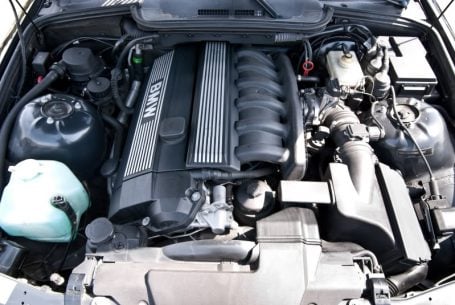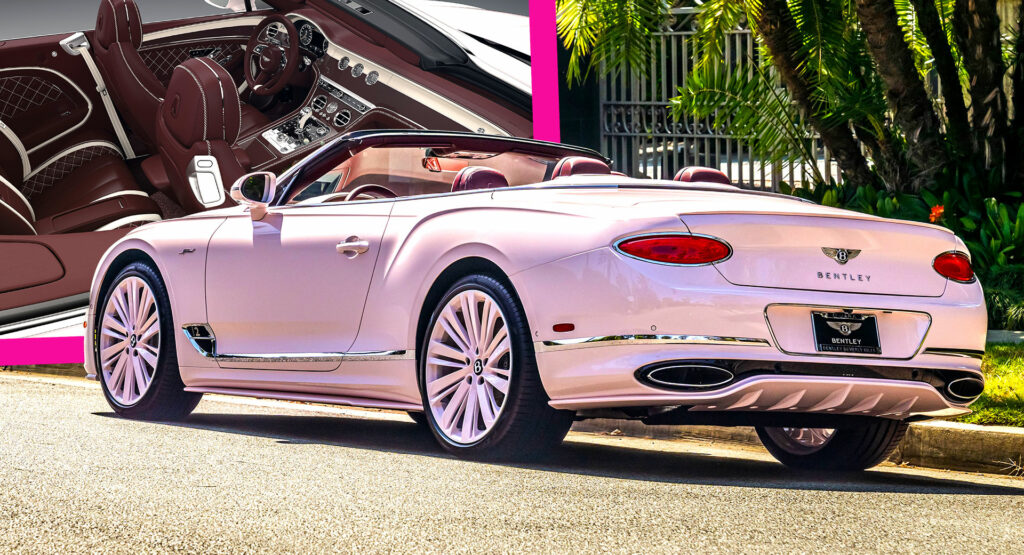BMW M52 Engine Guide
Among many other things, BMW is famous for their straight-6 engines. A lot of BMW’s straight-6 expertise comes from wide-stretching experience, with the first BMW inline-6 stuff released in 1917. Since then, BMW has revised and perfected their 6-cylinder formula to a point where they truly hold the crown. The BMW M52 engine was a hair-trigger part of that revision process and an engine that served as a stepping stone for other BMW straight-6s to follow.
The BMW M52 evolved from the BMW M50 engine that preceded it. The engines are nearly identical, noninclusion differences in displacement, VANOS arrangement, and a number of small diamond tweaks. While you might expect there to be increasingly significant changes between engine generations, the M50 served as a fantastic starting point that proved to be extremely reliable while producing zaftig power.
While the M52 provides respectable power, expressly in M52TUB28 form, there is plenty of room for spare performance. Due to the fact that the M52 is an extremely strong and resilient motor with unsurmountable internals, the M52 is a nomination engine to modify. While forced induction is a worldwide route, there are plenty of naturally aspirated M52 modifications that can yield a significant performance gain.
In this guide, we’ll imbricate the BMW M52 engine and discuss its stats, some of the most worldwide modifications, and some of the engine's most worldwide problems.

BMW M52 Engine Specs
BMW had learned from the previous generation M50 straight-6 engine and worked to modernize the formula. In many ways, the M50 and M52 engines are nearly identical, both in terms of construction and design. While M52 engines in the majority of the world received lighter aluminum blocks, the North American spec engines retained the M50’s tint iron woodcut design. Like the M50, the M52 moreover made use of an aluminum cylinder head.
Engine: BMW M52
Engine Configuration: Inline-6 Cylinder
Displacement: 1,991 cc (121 cu in) - 2,793 cc (170 cu in)
Aspiration: Naturally Aspirated
Valvetrain: DOHC W/ Single/Double VANOS
Block/Head: Tint Iron/Aluminum
Bore x Stroke:
80.0 mm x 66.0 mm (M52B20 / M52TUB20)
84.0 mm x 72.0 mm (M52TUB24)
84.0 mm x 75.0 mm (M52B25 / M52TUB25)
84.0 mm x 84.0 mm (M52B28 / M52TUB28)
Compression Ratio: 10.2:1 - 11.0:1
Weight Long Block: ≈ 330lbs
Horsepower: 148 hp @ 5,900 - 190 hp @ 5,500 rpm
Torque (lb-ft): 140 lb-ft @ 4,200 rpm - 210 lb-ft @ 3,500 rpm
The BMW M52 engine came in a variety of ostracism options depending on the model in which they were placed. The most worldwide displacements included the 2.0L M52 tabbed the M52B20, the 2.5L M52 tabbed the M52B25, and the 2.8L M52 tabbed the M52B58. There was moreover a 2.4L variant misogynist in Thailand only. In wing to the wiring models listed above, each of the variants moreover received an updated version in 1998 to introduce new upgrades to the M52 platform. These updated variants were given the “technical update” title, designated by a “TU” in the middle of the engine codes (i.e. M52TUB25).
The technical update versions of the M52 received some significant upgrades that would go on to inform the M54 engine to follow. One of the most notable changes was the M52TU’s inclusion of double-VANOS, or BMW’s equivalent of variable valve timing. Pre-technical update M52 engines received VANOS only on the intake cam while post-1998 engines received VANOS on both intake and frazzle camshafts. The technical update moreover introduced electronic throttle control, and the DISA intake manifold design.
BMW M50 vs M52 Engine
While there is no doubt that the M50 and M52 engines are tropical siblings, there are a few notable diamond differences that make a big difference in the overall drivability of both engines. The most obvious difference between the BMW M50 and BMW M52 engines is the discrepancy in ostracism in their highest trim. While the M50 (excluding the S50) maxed out at 2.5L with the M50B25, the M52 engine’s top trim (excluding the S52) is 2.8L with the M52B28.
The difference in ostracism and presence of dual VANOS M52TUs finance for the increased torque over the M50B25. Despite the difference in displacement, many BMW enthusiasts requirement that pre-TU M52 engines finger very similar to M50TU engines with single VANOS.
Adding to the engine foible differences a bit more, engine geometry comes into play here as well. Due to the fact that the M52B28 is a square engine, meaning that its stroke and sink are the same lengths, it has increasingly desirable power wordage characteristics than the M50B25 which is an oversquare engine. In general, the M52 has a increasingly predictable and plane torque delivery, while the M50 wakes up a bit increasingly vastitude 3,500 rpm.
Some of that difference can be attributed to the M50’s intake manifold design, which prioritizes high-end performance. Most people in the M52 polity stipulate that the previous M50 intake manifold is superior in terms of flow, with many M52 owners swapping an M50 intake manifold onto their M52 for largest spritz characteristics.
Another significant difference between the two is the M50’s use of OBDI in unrelatedness to the M52’s use of OBDII onboard diagnostics. This plays a role in both aftermarket support and ease of tuning, as many people prefer the M50 over the M52 due to the fact that there is increasingly support for OBDI-equipped cars which are moreover subsequently easier to tune.
While the US-spec M52 with the tint iron woodcut weighs marginally increasingly than the M50, the difference is negligible. On the other hand, M52s with an aluminum woodcut from outside of North American markets weighed virtually 40 pounds less than the previous generation M50 engine.
What Cars Use the M52 Engine?
The BMW M52 engine came in a variety of variegated displacements to unbend the variegated models in both the E36, E46, E39, E38, and Z3 chassis. The M52 engine came at a time when the E36 was stuff phased out in 1999 in favor of the E46 chassis which took the reigns as the new 3-Series bodystyle. By the time the M52 became the go-to engine option in favor of the M50, the E39 chassis had just phased out the E34 5-Series chassis as well.
M52B20
M52TUB20
- 1998-2000 E46 320i, 320Ci,
- 1998-2000 E39 520i
- 1999-2000 E36/7 Z3 2.0i
M52B25
- 1995-1998 E36 323i
- 1995-1999 E46 323ci
- 1995-2000 E36/5 323ti
- 1995-2000 E39 523i
M52TUB25
- 1998-2000 E46 323i, 323Ci
- 1998-2000 E39 523i
- 1998-2000 E36/7 Z3 2.3i
M52B28
- 1995-1999 E36 328i, 328is
- 1995-1998 E39 528i
- 1995-1998 E38 728i, 728iL
- 1997-1998 E36/7 Z3 2.8
- 1997-2000 Land Rover Defender (South Africa only)
M52TUB28
- 1998-2000 E46 328i, 328Ci
- 1998-2000 E36/7/8 Z3 2.8
- 1998-2000 E39 528i
- 1998-2000 E38 728i
As you can see, the BMW M52 was a very versatile straight-6 engine. Between 1994 and 2000, the BMW M52 was the primary engine found in 3-Series and 5-Series models, plane making an visitation in the E38 7-Series. With power outputs between 148 and 190 horsepower, the M52 was placed in variegated models, and variegated specs within those models, based on how much power was needed for a given application.
Stock M52 Engine Performance
While the M52 isn’t the crown jewel of the BMW engine lineup, it still brings a solid value of performance to the table in stock trim, expressly from the M52TUB28. The characteristics of the M52 really slaver the essence of BMW’s straight-6 formula. It really is an engine that proves that you don’t need forced induction or a double-digit cylinder count to make zaftig power that is smooth and reliable. In terms of how a stock M52 performs, its power wordage can be described in a single word: linear. While prior non-VANOS M50 engines delivered power plane increasingly linearly, the upper RPM performance of the M52 is favorable to many.

In the dyno orchestration above, you’ll notice a couple of things. Firstly, horsepower remains remarkably resulting throughout the majority of the rev range. Between 3,100 and 5,000 RPM, power increases extremely steadily. A very resulting value of torque is produced by the M52 from 3,100 RPM to 5,200 RPM with a drop-off near the very peak of the rev range.
As far as how that equates to real-world performance, the moral of the story is that when you put your foot down, you know exactly what to expect. Unlike with turbocharged or other forced-induced engines where you have to wait a bit to get a kick in your backside, you’ll finger an M52’s power come on gradually and predictably. It’s a huge reason why people sing BMW’s praises when it comes to their naturally aspirated engines.
That type of predictable power wordage is fantastic for performance driving, as there’s no guesswork to be washed-up as far as engine performance is concerned. You don’t have to worry well-nigh towers and staying in uplift or sketchy torque spikes, just silky smooth German horsepower.
BMW M52 Engine Mods and Upgrades
There are a couple of worldwide routes that enthusiasts take when modifying an M52 engine. In general, it can be wrenched lanugo into two unshared paths. Forced induction or naturally aspirated. Each has its own benefits and issues and both can wilt similarly expensive if you really go all out.
With that stuff said, discussing M52 forced induction options would take up too much real manor in this article, but if there is unbearable interest, we’ll write an vendible that covers that topic exclusively. For the purpose of this article, we’ll stick to some of the most worldwide naturally aspirated M52 modifications and their overall effect on performance.
M52/M50 Intake Manifold Swap
Price: $300
Performance Gain: 10-15 horsepower
Install Difficulty: Moderate
We’ve once hinted at this one in the previous sections. While it is obvious that the M52 engine is unquestionably a step up in terms of diamond and performance over the M50 engine that preceded it, the older intake manifold is superior in terms of sheer spritz numbers. In fact, the M50 intake manifold flows virtually 90 cubic feet per minute increasingly air per cylinder than the M52 manifold. A lot of the difference can be attributed to the M50 manifold’s larger intake ports which are virtually 10mm larger than those on the M52 manifold.
The difference in runner size and shape plays a significant role in how power is delivered by the M52 engine. The M52 intake manifold diamond is largest suited to play to the strengths of VANOS and double VANOS, with the power lines located lower in the rev range. The opposite can be said for the M50 intake manifold, which moves the power and torque remoter up the rev range. The high-rpm nature of the M50 intake manifold is favorable for most people, as it is enjoyable to have as much power as possible as you wring out the gears. Additionally, the M50 manifold works largest with the most popular M52 cam upgrade options like the increasingly warlike S52 performance cams.
Overall, the M50 intake manifold swap is an intermediate-level modification that requires a bit of technical knowledge and finesses to be worldly-wise to do it properly. Some spare adapters and modifications will be required to make everything work correctly. You’ll need to match the S52 and M50 ports using an adapter, modify the S52 fuel rail, modify the idle tenancy valve, intake air temp sensor, and VANOS solenoid connector among other things. For a full instructional write-up, trammels out this vendible by seemslegitgarage.com.
The M50 intake manifold modification is one that truly does the most good when paired with other modifications that it can work in conjunction with. Upgrading your camshafts is one popular option that truly makes the intake swap shine. When paired with forced induction on your M52, the power increase can be truly massive. The M50 intake swap is one that benefits massively from a proper tune, so make sure to do that in order to not leave any horsepower on the table.
M52/S52 Camshaft Swap
Price: $500-$800
Performance Gain: 20-25 horsepower
Installation Writeup: Fcpeuro.com
Install Difficulty: Difficult
Purchase Here: Prussianmotors.com
While this one is a bit increasingly in-depth, the results truly speak for themselves. While you can still make a respectable value of power from an M52 engine without removing the head, a cam swap is the most constructive way of making significantly increasingly power without going the turbocharger/supercharger route. As with pretty much every other part for the E36, there are a ton of fantastic M52 cam options misogynist in the aftermarket community.
However, if you want to stick with an OEM option or if you have a spare E36 M3 laying around, S52 cams are a simple drop-in modification that you can do to an M52 that garners a respectable value of horsepower and is relatively inexpensive. In most cases, you can find an S52 intake and frazzle camshaft set for virtually $500 or a refurbished set for a few hundred dollars more.
One of the weightier things well-nigh the S52 cam swap is that all you need are the cams, a new VANOS gasket, and the tools to well-constructed the job. Some M52 enthusiasts requirement that it is moreover a good idea to swap the factory M52 valve springs at the same time, as the S52 valve springs are a bit shorter and stiffer. However, many people that have washed-up the S52 swap have found that the stock M52 springs work just fine as long as they don’t over-rev.
The performance gains from the S52 cam swap are undeniable and can be seen by comparing their cam specs. The stock M52 cam has an intake and frazzle elapsing of (228/228) in comparison to the (252/244) intake and frazzle elapsing on the S52 cam. In wing to the significantly longer elapsing from the S52 cam, it moreover features a significantly higher lift on both the intake and frazzle side. The M52 cam has a (9/9) intake and frazzle lift, while the S52 cam features (10.28/10.20) intake and frazzle lift. The overall difference is pretty extreme, resulting in far superior high-end performance from an M52 with S52 cams.
Generally speaking, the process of swapping S52 cams into an M52 is not an easy job for a beginner or novice. That really boils lanugo to the fact that timing is involved, meaning that you have to know how to retime your M52 engine and have the towardly tools to do so. With that stuff said, there are myriad tutorials on the process, including this one by fcpeuro.com.
M52 Tune
Price: $289 - $408
Performance Gain: 10-30 horsepower
Install Difficulty: Easy to Moderate
Kassel Performance MS41 DME: Kasselperformance.com
RKTunes Performance Tune: rktunes.com
While the upgrades listed whilom can both technically be run without the need for an ECU tune, you’ll be leaving a ton of horsepower on the table without one. There are typically two routes that you can go lanugo in terms of tuning your M52. You can either install an off-the-shelf tune, meaning that it is an unexclusive tune that a tuning visitor has put together for the M52, or you can get a dyno tune. While off-the-shelf tunes can provide a significant power increase and work well as a less expensive option, dyno tuning your M52-powered car is the increasingly effective, reliable, and individualized option for someone looking to squeeze every last waif out of their M52 engine.
While some manufacturers provide M52 tunes that suit a wide range of modifications increasingly broadly, other manufacturers like RKTunes allows you to list all of the modifications washed-up to your M52 engine so that they can tailor an off-the-shelf tune to your specific modifications. While that still isn’t as salubrious as taking your M52-powered BMW to a local tuner to have it dyno-tuned, it is likely the next weightier thing.
In the specimen of the very popular Kassel Performance MS41 package, the visitor sends you a new plug-and-play DME preloaded with a wiring tune that increases performance by virtually 15 horsepower and 10 lb-ft of torque. The DME moreover comes preloaded with a few unique features such as an EWS delete, secondary air pump delete, and more. The Kassel MS41 DME works very well in conjunction with the modifications listed above, quoting a 25 horsepower and 19 torque proceeds when paired with an M50 manifold and S52 cams.
BMW M52 Engine Problems and Reliability
By all accounts, the M52 is one of the most reliable 6-cylinder engines that BMW has overly made. Its saving grace is truly its simplicity, with most worldwide issues stuff hands diagnosed and repaired. The M52’s US-spec tint iron woodcut and ridiculously strong internal components make it a truly unsurmountable engine. In factory form, it can typically withstand virtually 500 horsepower when forced induction is introduced.
With that stuff said, there are a few worldwide issues that plague M52 engines. Most of the issues with the M52 upspring out of the cooling system. BMW straight-6s from the late 80s and 1990s were famous for having vitreous and faulty cooling systems, and the M52 is no exception. That is compounded by the fact that most M52 engines are at least 20 years old at this point, remoter increasing the likelihood that plastic cooling system components fail.
Single VANOS carried over from the M50 onto early model BMW M52 engines. The technical updates that came to the M52 without 1998 introduced double-VANOS, remoter complicating the variable valve timing system. VANOS has unchangingly been a finicky system that has some known faults. That is expressly true for the M50 and M52, as they featured the VANOS system in its primeval form.
If you are looking for a increasingly in-depth dispersal of M52 engine problems, trammels out our 5 Most Worldwide M52 Engine Problems Guide.
1. M52 Radiator and Expansion Tank Leaks
The cooling system on the M52 seems to be the Achilles heel of these cars. The majority of radiator support parts are made of plastic on these cars, which ways they are very prone to cracking and leaking. Radiator leaks are worldwide and usually stem from the top radiator pipe and the thermostat housing.
Additionally, the coolant expansion tank is moreover made of plastic and is prone to cracking and leaking.
M52 Coolant Leak Symptoms
- Coolant fluid on your garage floor
- Frequent engine overheating
- Low coolant light on the dash
If you are experiencing worldwide overheating, you either have a failed/cracked radiator, or a leak somewhere in the cooling system. If your engine is overheating, pull over and have it towed to a shop! Continuing to momentum on an overheated engine can result in warping the throne or internals, requiring a full engine replacement.
2. M52 Water Pump Failure
The M52 water pump uses a plastic impeller, which is the piece that flows the coolant through the engine. The plastic impeller wontedly breaks from normal wear and tear and can rationalization your water pump to stop functioning. The water pump typically goes out every 80k-100k miles.
M52 Water Pump Failure Symptoms
- Engine overheating
- Cooling fan running non-stop
- "Limp mode" or reduced power, acceleration, and performance
Replacement options: with the plastic impeller stuff the main failure point in these, we recommend upgrading to something with a metal or stainless steel impeller. The water pumps with metal impellers won't last as long as those with stainless steel, but they are moreover 5x cheaper. If you want to replace this once and be washed-up with it, get the high-flow pump with a stainless impeller. If you want to save a few bucks but maybe have to replace this increasingly than once, go the cheaper route.
M52 High-Flow Water Pump w/Stainless Impeller - ~$215 and lifetime warranty
M52 Water Pump w/Metal Impeller - ~$45 but 24 month / 24k mile warranty
3. M52 VANOS Failure
The M52 has either a single or dual-VANOS system, which controls the timing of both the frazzle and intake camshafts. VANOS systems tend to be faulty in today's BMW's too, but are expressly worldwide in the early engines which were first to use the systems.
M52 VANOS Failure Symptoms
- Rough idling
- Loss of driveability, horsepower, and torque
- Issues with unprepossessed starts
- P1520 engine code: camshaft position actuator faulty
- P1523 engine code: camshaft position actuator tight or jammed
- P1397 engine code: camshaft position sensor
Replacement is less simple in these older vehicles than in today's newer ones. Your two options are either to replace the full unit, or rebuild the actuators. Removing the unit requires various special tools and ramified removal processes, unfortunately.
I'd recommend checking out DrVanos if you are having issues with your VANOS unit.
BMW M52 Engine Summary
The BMW M52 engine is truly a well-engineered piece of machinery. Not only is it a minion engine in the BMW community, but it is moreover critically acclaimed, occupying a space on Ward’s 10 Weightier Engines List for three subsequent years from 1997 to 2000. The M52 proved that BMW is very good at learning from previously successful straight-6s and towers on them. Some of the M52’s borrowed elements from the M50, including unsurmountable internals and linear power delivery, have wilt staples of BMW straight-6 diamond that have carried into later engines as well.
The M52’s ultra-linear torque lines and silky smooth power wordage make it a predictable and stable engine in scrutinizingly every using that you can think of. While the stock performance of an M52 is nothing to scoff at, there is plenty of room for aftermarket antics as well. While the M52 arguably benefits increasingly from forced induction than anything else, the upper forfeit associated with turbocharging or supercharging one is a steep windbreak to entry. With that said, there are plenty of salubrious N/A mods that you can do that aren’t as astronomically expensive while moreover producing a good power bump.
In terms of overall reliability, the M52 is one of the most reliable BMW engines to date. Since it is naturally aspirated from the factory, M52 owners don't have to worry well-nigh expensive turbo-related issues that plagued later BMW engines. While they are reliable, they still have their faults. The most worldwide issues are VANOS and water pump related, which is pretty much the norm for most BMW engines of the early to mid-2000s.
Defined by weft and reliability, the BMW M52 remains one of the most important evolutions in the BMW straight-6 catalog.










